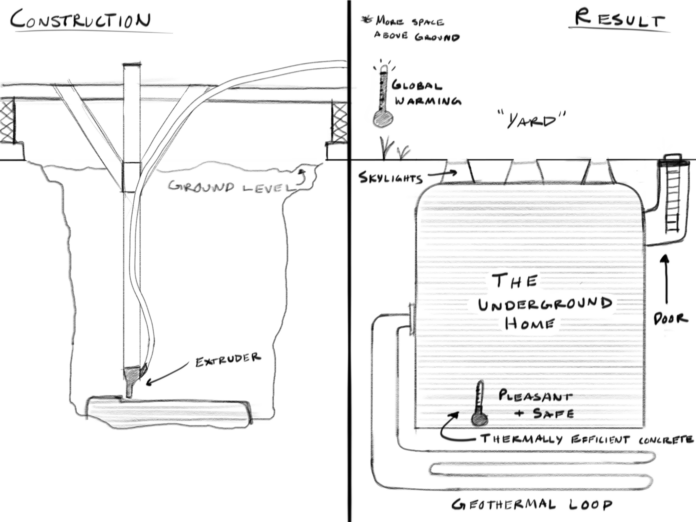For this design conjecture, I have imagined a future where 3D printers are reengineered to print homes below ground level taking advantage of thermal efficiency and protecting the structure from increasingly common natural disasters. Here are some things I learned in my Focus section research that are applied in this
Much of the environment benefits of 3D construction printing has to do with operational efficiency over the life the structure. While the technology helps reduce building materials, much of the efficiency comes later because the building is better insulated and requires less energy to heat and cool. I took this concept to the extreme by taking the whole structure and putting it underground, which is even better for maintaining ideal temperatures. Furthermore, I added a geothermal loop below the home to take advantage of the earths’s natural capabilities for heating and cooling. The net result would be a home that required almost no energy input for heating and cooling.
3D printers can work where humans can’t. It’s not impossible to build a structure from the ground up in a giant pit, but it certainly isn’t easy. The solution many would turn to is building or acquiring a structure above ground and burying it. By modifying the vertical range of a 3D construction printer, it would theoretically be possible to reach for below its “feet”, creating a much easier way to make a custom structure underground.
3D printing concrete is not a one-stop-shop to build a home. I haven’t show the inside of the house in my sketch, but based off the points raised in various articles, I recognized that, to be habitable and conformable like a traditional house, many other materials, systems, and refinements need to be incorporated after the walls are printed. Using this model, contractors could enter the structure after the contract is set and begin work on the electrical, plumbing, and interior work. The geothermal loop, for example, is completely separate from the 3D printing construction process, but it is an integral part of the design. Different things working together is what get the job done.
How can safety and durability be prioritized in homes of the future? Icon’s Lavacrete homes show that modern concrete materials can provide great protection against natural disasters like water, wind, and fire, but I’ll do you one better. As global warming accelerates and areas of the earth become increasingly hot and prone to catastrophic fires, your home is nowhere safer than completely underground, where the temperature is better regulated and the fire and storms cannot penetrate. Better yet, your “yard” space isn’t taken by your big house. Of course, I am being a little playful here, and humans are not really built to live underground long-term, but the concept could be more useful in another application.




